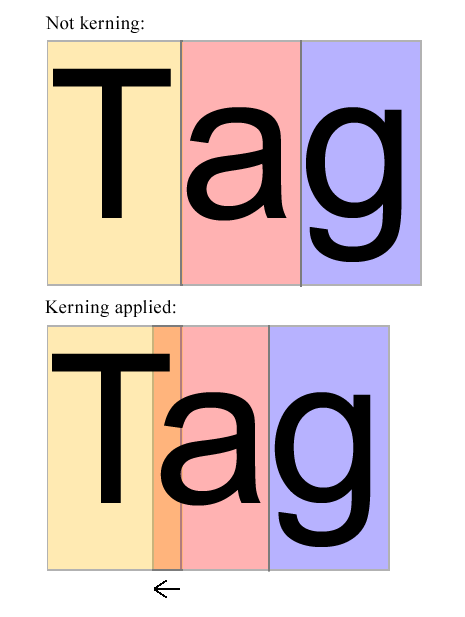Do anyone know any algorithm which would calculate automatically kerning of characters based on glyph shapes when user types text?
I don't mean trivial calculation of advance widths or similar, I mean analyzing the shape of glyphs to estimate the visually optimal distance between characters. For example if we lay out three characters sequentially in a line, the middle character should SEEM to be in the center of the line despite of the character's shapes. An example enlightens the kerning-on-the-fly functionality:
An example of kerning-on-the-fly:

In the above image a seems to be too right. It should be shifted a certain amount towards T so that it seems to be in the middle of T and g. The algorithm should examine the shapes of T and a (and possibly other letters also) and decide how much a have to be shifted to the left. This certain amount is the thing that the algorithm should calculate - WITHOUT EXAMINING THE POSSIBLE KERNING PAIRS OF THE FONT.
I'm thinking of coding a javascript (+svg+html) program that uses hand drawn fonts and many of them lacks kerning pairs. The textfields will be editable and can include text of multiple fonts. I think that kerning-on-the-fly could be one way to ensure mean text flow in this case.
EDIT: One starting point to this could be to use svg font, so it's easy to get path values. In svg font the path is defined this way:
<glyph glyph-name="T" unicode="T" horiz-adv-x="1251" d="M531 0v1293h
-483v173h1162v-173h-485v-1293h-194z"/>
<glyph glyph-name="a" unicode="a" horiz-adv-x="1139" d="M828 131q-100 -85
-192.5 -120t-198.5 -35q-175 0 -269 85.5t-94 218.5q0 78 35.5 142.5t93
103.5t129.5 59q53 14 160 27q218 26 321 62q1 37 1 47q0 110 -51 155q-69 61
-205 61q-127 0 -187.5 -44.5t-89.5 -157.5l-176 24q24 113 79 182.5t159
107t241 37.5 q136 0 221 -32t125 -80.5t56 -122.5q9 -46 9 -166v-240q0
-251 11.5 -317.5t45.5 -127.5h-188q-28 56 -36 131zM813 533q-98 -40 -294
-68q-111 -16 -157 -36t-71 -58.5t-25 -85.5q0 -72 54.5 -120t159.5 -48q104
0 185 45.5t119 124.5q29 61 29 180v66z"/>
The algorithm (or javascript code) should examine those paths some way and determine the optimal distance between them.
